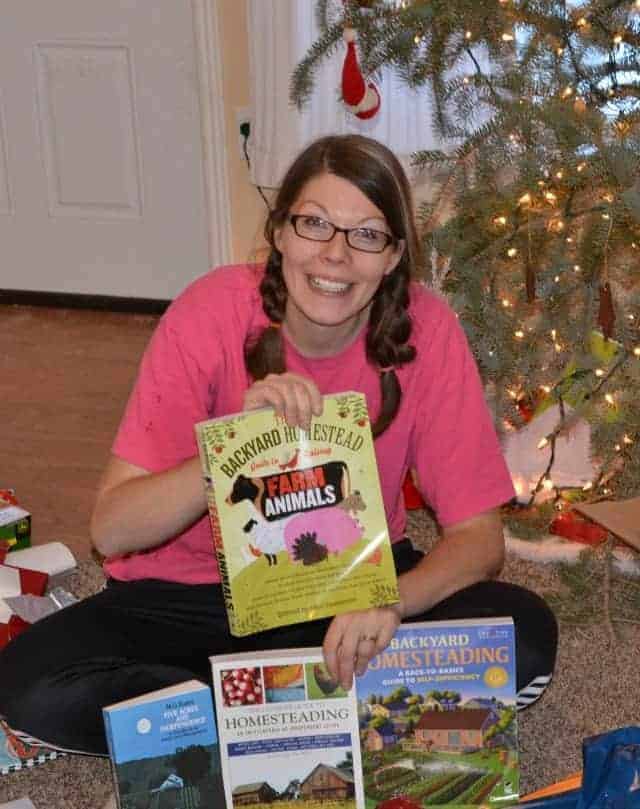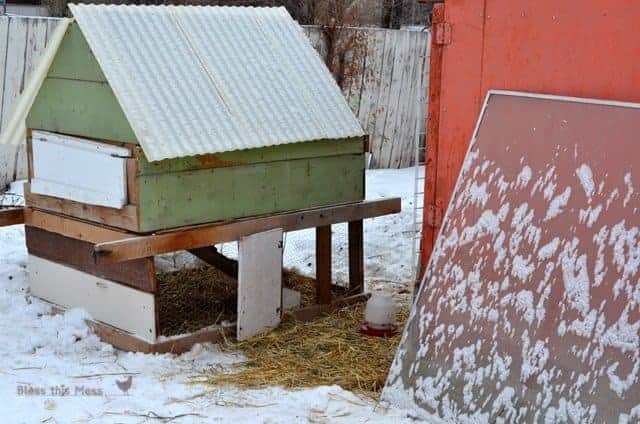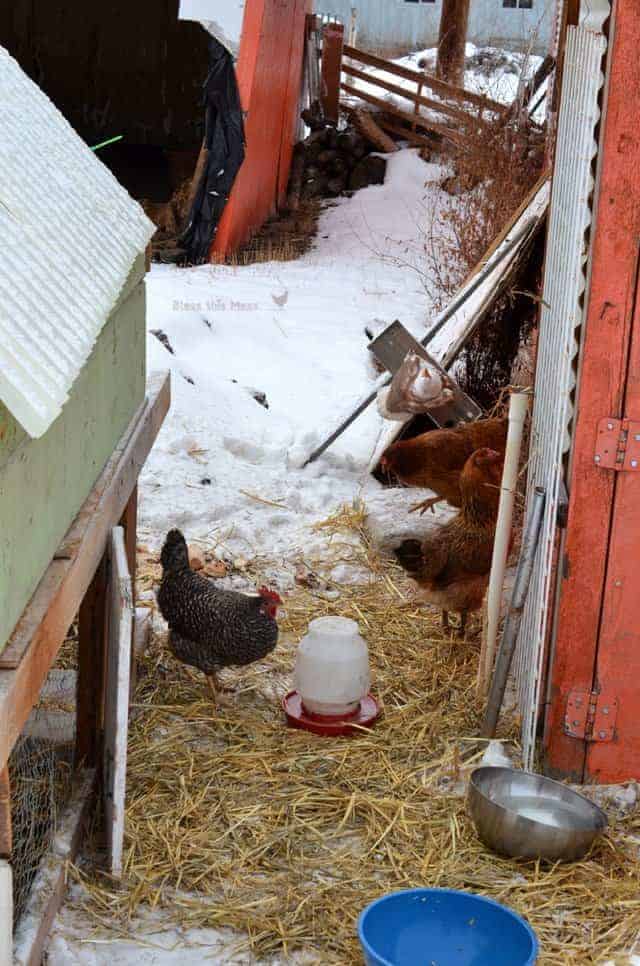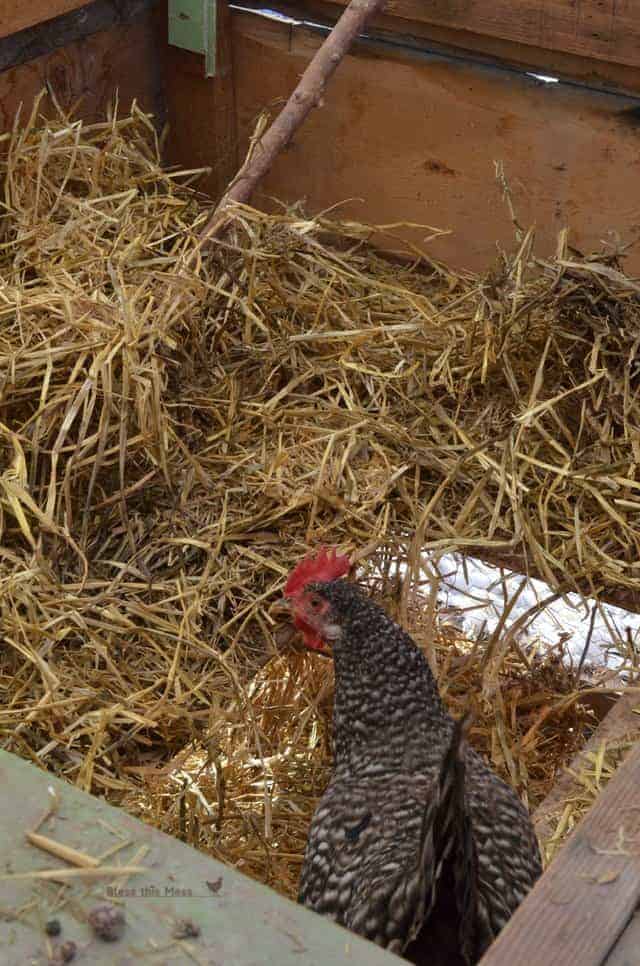Backyard Chickens in the Snow
on Jan 16, 2013, Updated Jun 27, 2024
This post may contain affiliate links. Please read our disclosure policy.
It’s been a while since I updated you on how the hens are doing.
I wasn’t very prepared for winter. Their coop is fine, but it’s not incredibly warm and is a bit drafty. I did some reading about the general needs of hens in the winter and most things suggested keeping a light or heat lamp inside the coop. Hens typically only lay eggs when there is 12 hours of sunlight in a day. Most of the time they will go into a natural rest period from egg production in the winter months. You can use a typical white light with a timer (start at 7am and shut off at 7pm) and the artificial light is enough to keep them laying. Most people also use a red heat lamp overnight for warmth. I would say this is what most people do with their hens in the winter.
I however, don’t have electricity out to my coop, since it is portable, and I wasn’t sure if I wanted to pay for the electricity since I only have three hens at the moment anyways. If getting the 6-8 eggs a day, that I did when I had nine hens, was an option I might have wanted the light more. I had a hard time justifying the expense for 2 or so eggs a day. (Here’s the sad post on why I only have three hens if you are new.)
So I kept reading. The artificial white light I decided was pretty optional, they would just stop laying. I have no problem with letting nature takes its course on that and decided against the white light.
Do they need heat? Common sense tells me yes. It is SO cold in this part of Utah. It’s been -7 a few days in the afternoon with the sun shining! It’s gotten colder than the negative teens during the night. Saying it’s cold just doesn’t do it justice… it’s knock the breath out of you cold. But, I still didn’t have electricity out to the coop. I found one site that said hens didn’t need heat, even in the coldest of winters. Again, I kept reading. It said that they produce about 10 watts of heat themselves and when they huddle together they can keep each other warm. It also pointed out that they are animals, and just because I would be completely miserable in the cold it wasn’t quiet the same for them. It also said that as the days and nights get colder with the season change, they would get adjusted. You can’t have a light on them and then just not turn it on one night because they won’t be used to the cold. It also said that if it really is too cold they will get frostbite on their combs (the red on top of their head).
I did some asking around too. My egg lady/chicken mentor thought they would need heat. An older lady from church told me that she had chickens when she was a child and they never had heat or light because they didn’t even have electricity then. I really thought about that last statement and she is right- chickens have been around, in the cold, a lot longer than heat lamps.
I took all that to heart in the fall and decided I would let them grow used to the cold but keep an eye on them. The first sigh of frostbite and I’d get them a light for the coldest nights. Here we are, the middle of January, and they seem absolutely fine. No frost bite, normally pleasant temperaments (chickens will let you know when they are stressed…), and here’s the best part two of them are still laying eggs!!
You heard me right, I’m still getting one or two eggs a day. Everything said they would stop laying, and one did completely, but two still lay! One lays every day and the other lays when it’s warmer than the teens during the day.
Things were comfy and cozy until Christmas day when Thomas got me all this treasure:

Can you tell what I’m pretty interested in? Anyhow, I spent my low-key Christmas morning scanning the books and reading the chicken sections. They made it pretty clear that hens need to stay clean and dry in the winter. They need to have fresh bedding and not step in their own poop or they can get sick for obvious reasons. This hadn’t been an issue until the beginning of December when it snowed. The ladies were terrified of the snow. They wouldn’t come out of the bottom of the coop at all. They stayed in there all of the time. Up until then there was no snow and they would still wander the yard eating as they went, even though lots of the plants were dead they still found plenty to peck at.
That snow really threw them for a loop. They were just so scared of it it was almost funny. A few days after the first snow I opened the top of the coop and they came up to see me. I picked them up and threw them out, making them go onto the snow (they had to get used to it!) and they flew and fluttered until they found something higher to perch on and just sat there. They wouldn’t move until I got tired of waiting to see what they would do and carried them back to the coop. Nutty birds! So they spent their days in the straw covered bottom.
After my Christmas reading though I knew we needed a change. Their straw was yucky now and I can’t clean it out very well (I normally move the coop and then clean up what’s left), but moving it meant they’d move on top of snow which is too cold and wet for them, so I brain stormed with Thomas outside in the cold on Christmas Day. We decided that they needed access to places that didn’t have snow so that they would come out of the coop. We looked around and a foot wide path across the edge of the barn was the only place clear of snow. I shoveled and cleared a new spot for the coop and then ended up using some old windows from the house to make places where the snow wouldn’t go.
Here’s what their set up looks like now:

The big window it propped up again the barn and I put straw under it and to it. They love walking on the straw and not the snow. I also put a big widow against the back side of the coop in hopes it would cut down on wind and maybe warm it up a bit more in the day.
This is the edge of the barn that didn’t have snow on it. They can scratch in the dirt here and hide behind the boards on this side of the barn with no snow in the way too. I also learned that if you can get them to eat more they will stay warmer, but they get bored eating their chicken food out of the bucket. So I bought chicken scratch which is mixed grains and it looks just like bird seed. They are birds after all. Now I sprinkle that here and there on top of the straw and they have something to scratch around in and find at the bottom. They really do like to eat all day long. In the summer they just roamed the yard, but now that it is winter I had to provide them with what they need.
I also fill the top of the coop, where they sleep, with hay ever few days. They kick it all out to the bottom and then step on it, but it keeps the bottom cleaner. Can you see the broken perch? When I had all of the hens they would sleep there and I guess one night they were just too heavy for it. I bet that breaking scared them to death! That hen is a black sex link and she lays white eggs when the weather is not too cold.
So my backyard chickens are doing really well, love their new set up, and I’m getting at least eight eggs a week. I’m really looking forward to getting new chicks in the spring again too. We bought them in April last year and that honestly feels like it is right around the corner!
Thanks for letting me share this fun new hobby with you. Backyard chickens are the best!









You should look into passive solar heating, super cheap and easy. There is one design that uses aluminum cans.
Such a good idea! I think I’ll look into that, thank you!
I have 3 Rhode island Reds and this will be my first winter for them in mid Illinois where our winters have gotten very very cold and our summers that use to be 95 is now averaging 75 weird weather changes. I too am worried and i was told to put a storage blanket over the coop then a tarp over that and that should keep the coop warm and without cold drafts. My coop is too small for a heat lamp and can not afford a bigger coop. My hens are 6 months yet only 1 is laying 1 egg every other day?? Maybe I am not feeding them the right food but i have 4 different bags of food/nutrients not sure how to deliver the foods like 4 different bowls?
It sounds like you are doing everything right! I hope they start laying soon. You can also use hay bales on the side that is the windiest or coldest for added insulation and lots of hay on the insdie so that they can make deep nests if they need to!
We had a tough winter here in PA too. This was my first winter also. I did have a red heat lamp when the temps got below 15 degrees. The hens did great, black austroups, and New Hampshire Reds. My black rooster did get frostbite on his comb but survived and is feisty as ever. Thanks for the post. It was informative and funny. I’m glad I’m not alone!!!
Oh Im so happy I stumbled onto this!!! I live in Utah also. I jst started raising my first chicks in March and I am in a situation where running electricity to the coop is jst way too expensive. I have been researching & brainstorming heat & light ideas for the winter & this helped sooo much!
Yea! So we just did our second winter without heat and it went great. Lots of straw for them to play in and snuggle down in for the cold nights goes a long way as well as making sure the coop isn’t drafty. The biggest issue is keeping the water from freezing… mine does, I just have 2 containers and I switch them daily. The second one will thaw in the house and then I’ll take it out and bring in the frozen water. Other than that they do really well! Breeds with shorter combs do better too because their short combs are less likely to get frostbite. Good luck friend!
Can anyone comment on whether you need to provide water for the chickens in winter or can/will they simply eat snow instead?
They will learn to eat the snow when they are out and about if they have to but they need fresh water all winter long for sure.
I have 6 chickens but I don’t use a heat lamp for them even in the coldest night. I always make sure they have plenty of food and water. I get around 4 or 5 eggs a day and this makes me happy. I’m planning on adding 3 chickens but I need to build a bigger house for them first.
It’s a little hard to tell the one in the background. She almost looks like a Rhode Island Red because of her color on my screen, but she looks bigger than some RIR. Our orange chickens are Buff Orpingtons (love them! They are beautiful and mellow.
Your mom is great at identifying birds! She’ll probably know. Yes, I’m sure the middle one is an Ameraucana. They are a mix of Araucanas and another breed (I don’t remember which one). Here’s a good site, although you may have already found it….https://www.poultryhub.org/ We’ve got a purebred Araucana rooster… he’s quite beautiful and isn’t too noisy.
We worried about our chickens the first year, too! Now we make sure they have plenty of food and water and a dry place to hang out and they are fine. The new chickens seem to lay through the winter, it’s the older ones that aren’t worth the food 🙁 But we keep them anyway… we just can’t bring ourselves to ‘put them in the pot.’ Is the chicken in the bottom photo really a Black Sex-link? She looks just like our Barred Rocks, which we love! I love Cochins, too but we don’t have any this year. Maybe next time we start a flock I’ll get a bunch again. So calm and gentle.
You are right… the Black sex-link was all black, she is a Barred Rock. I obviously haven’t gotten all the breeds matched to their names yet… LOL. Do you know what kind the orange one in the background of the second picture is? I think one is an Ameracuna, but I’m not sure on the other.
Great post! It’s our first year having chickens too, and I’ve been waiting for our chicken’s egg production to slow… but they just keep coming! 🙂
I’m afraid they’re going to stop in late winter, and not ramp back up in time for Easter- necessitating buying eggs for coloring… that would be just my luck!!!
How many hens do you have?! And are you keeping them on lights at all? What kind of chickens? Are they the best pets ever!